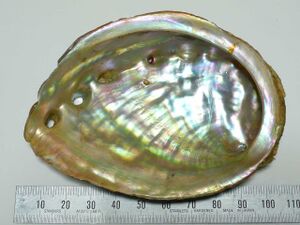Abalone (nonfiction): Difference between revisions
No edit summary |
No edit summary |
||
| (3 intermediate revisions by the same user not shown) | |||
| Line 1: | Line 1: | ||
[[File:Abalone.jpg|thumb|Abalone.]]'''Abalone''' (æbəloʊni or æbəˈloʊni; via Spanish ''abulón'', from the Rumsen language ''aulón'') is a common name for any of a group of small to very large edible sea snails, marine gastropod molluscs in the family ''Haliotidae''. | [[File:Abalone.jpg|thumb|Abalone.]]'''Abalone''' (æbəloʊni or æbəˈloʊni; via Spanish ''abulón'', from the Rumsen language ''aulón'') is a common name for any of a group of small to very large edible sea snails, marine gastropod molluscs in the family ''Haliotidae''. | ||
Other common names are ear shells, sea ears, and muttonfish or muttonshells in Australia, ormer in Great Britain, and pāua in New Zealand. | Other common names are ear shells, sea ears, and muttonfish or muttonshells in Australia, ormer in Great Britain, and pāua in New Zealand. | ||
| Line 7: | Line 5: | ||
Abalone are marine snails. | Abalone are marine snails. | ||
The shells of abalones have a low, open spiral structure, and are characterized by several open respiratory pores in a row near the shell's outer edge. | |||
The | The thick inner layer of the shell is composed of [[Nacre (nonfiction)|nacre]] (mother-of-pearl), which in many species is highly iridescent, giving rise to a range of strong, changeable colors, which make the shells attractive to humans as decorative objects, jewelry, and as a source of colorful mother-of-pearl. | ||
The | The flesh of abalones is widely considered to be a desirable food, and is consumed raw or cooked in a variety of cultures. | ||
== | == In the News == | ||
<gallery mode="traditional"> | |||
</gallery> | |||
== | == Fiction cross-reference == | ||
* [[Abalonia]] | |||
== Nonfiction cross-reference == | == Nonfiction cross-reference == | ||
* [[Nacre (nonfiction)]] | * [[Nacre (nonfiction)]] | ||
External links: | |||
* [https://en.wikipedia.org/wiki/Abalone Abalone] @ Wikipedia | * [https://en.wikipedia.org/wiki/Abalone Abalone] @ Wikipedia | ||
Latest revision as of 18:28, 24 June 2016
Abalone (æbəloʊni or æbəˈloʊni; via Spanish abulón, from the Rumsen language aulón) is a common name for any of a group of small to very large edible sea snails, marine gastropod molluscs in the family Haliotidae.
Other common names are ear shells, sea ears, and muttonfish or muttonshells in Australia, ormer in Great Britain, and pāua in New Zealand.
Abalone are marine snails.
The shells of abalones have a low, open spiral structure, and are characterized by several open respiratory pores in a row near the shell's outer edge.
The thick inner layer of the shell is composed of nacre (mother-of-pearl), which in many species is highly iridescent, giving rise to a range of strong, changeable colors, which make the shells attractive to humans as decorative objects, jewelry, and as a source of colorful mother-of-pearl.
The flesh of abalones is widely considered to be a desirable food, and is consumed raw or cooked in a variety of cultures.
In the News
Fiction cross-reference
Nonfiction cross-reference
External links:
- Abalone @ Wikipedia
- Abalone diving season is off to a hazardous start in California @ Boing Boing
